The Need to Belong, Is Technology Harming our Children’s Health?, A History of Fingerprinting – IELTS Reading Answers
20 min read
Updated On
-
Copy link
Table of Contents

Limited-Time Offer : Access a FREE 10-Day IELTS Study Plan!
The Reading Module of the IELTS can be the top-scoring category, with diligent practice. To achieve the best results in this section, you must understand how to approach and answer the different Question types in the Reading Module. By solving and reviewing Sample Reading Questions from past IELTS papers, you can ensure that your Reading skills are up to the mark.
In the Academic Reading practice test, “The Need to Belong, Is Technology Harming our Children’s Health?, and A History of Fingerprinting” there are 40 questions of various question types. We at IELTSMaterial.com would urge every IELTS aspirant to time this test as in the real exam and find the answers without looking at the key. If you have scored 40/40, then we wish you all the best. If you haven’t, then we would earnestly advise you to take one of our IELTS reading practice tests.
Here are question types in this reading test
Reading Passage 1 (The Need to Belong)
- Summary completion
- Flowchart completion
- Multiple Choice Questions
Reading Passage 2 ( Is Technology Harming our Children’s Health?)
- Table completion
- Yes/No or Not Given
- Short answer questions
Reading Passage 3 ( A History of Fingerprinting)
- Matching headings
- Sentence sompletion
- True or False / Not Given
Reading Passage 1
The Need to Belong
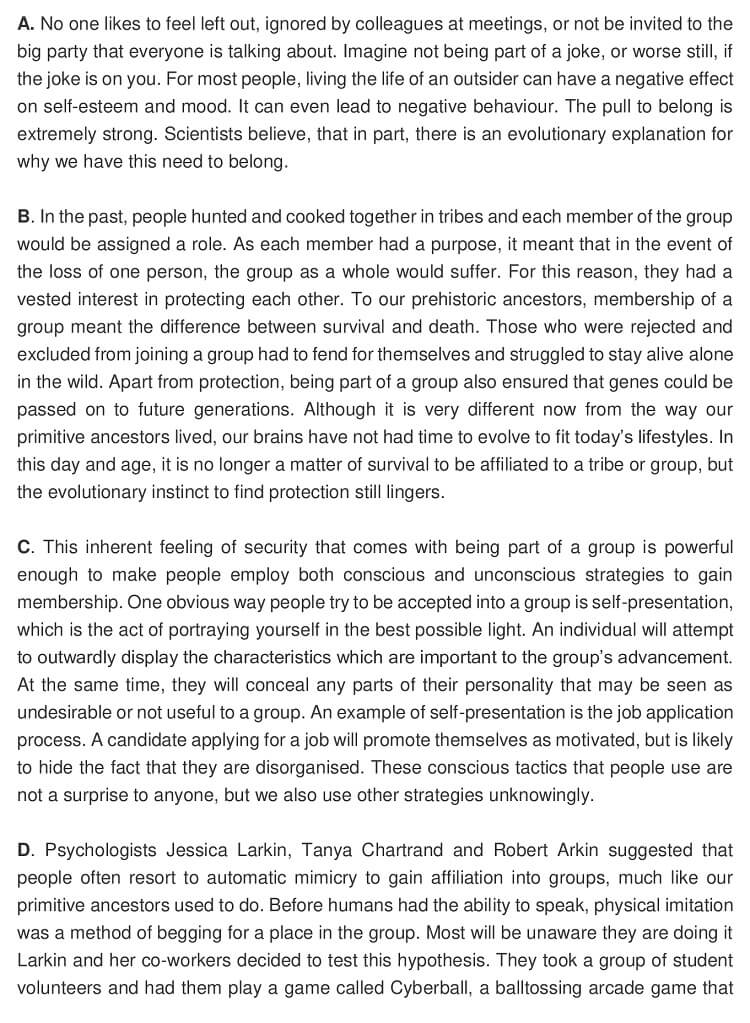
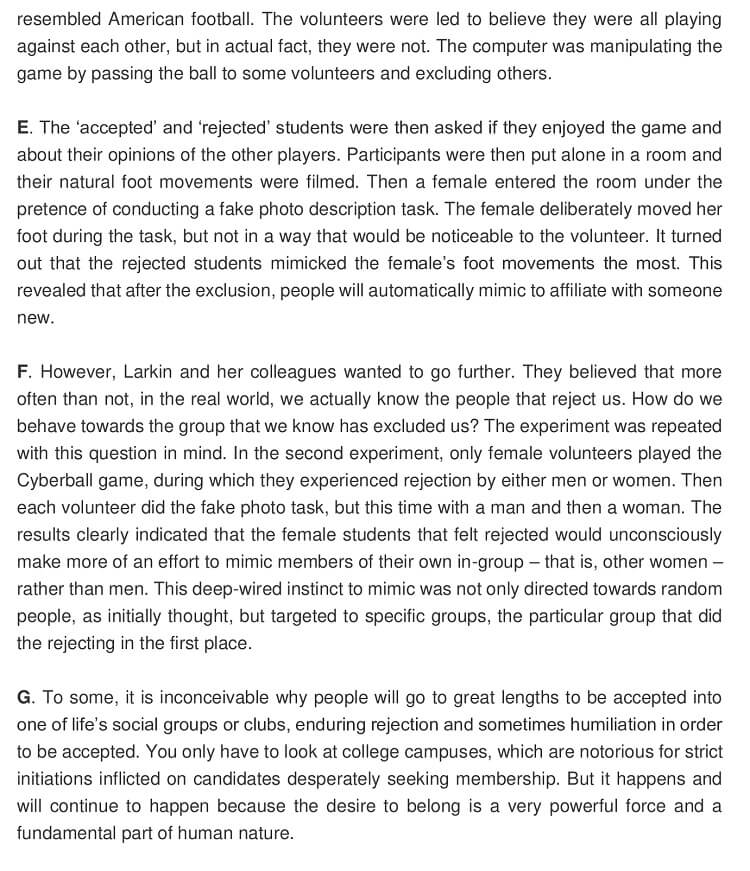
[do_widget id=custom_html-23]
Questions 1-5
Complete the summary.
Choose NO MORE THAN TWO WORDS from the passage for each answer.
Modern man’s basic need to belong to clubs and groups dates back to early history. Each person within the group had a 1____________________________ to play and was considered integral to the entire groups dynamics and success. For an individual, belonging to a group could affect their chances of 2_______________________________ In those times, few could avoid death living alone in 3_________________________. Living with other humans offered
4_________________________ from danger. Staying in a group also meant that
5____________________________ could be passed down to descendants.
Question 6-10
Complete the flow chart below
Use NO MORE THAN THREE WORDS from the passage for each answer.
The Procedure For Larkin’s Experiment
Volunteers believed they were playing a computer game, similar
to 6……………………………….
The computer was controlling the gameplay, 7………………………….. to some and not others.
The volunteers gave their 8…………………………………. after the game.
Each volunteer first sat on their own in a room and had their foot movements
9………………..
The volunteer took part in a task with a woman who 10……………………………….. on purpose.
Question 11-13
11 Which of the following is NOT mentioned in the first paragraph?
A one experts view on evolution
B the consequences of being excluded
C being made fun of by the people around you
D a social event that people are eagerly awaiting
12 According to the article, which method do people consciously use to obtain membership into their chosen group?
A They tell the group they are strongly motivated.
B They convey the best parts of their personality to the group.
C They show how the group will be important to their lives.
D They alter aspects of their personality to suit others.
13 The writer’s main purpose in writing this article is to
A explain how people feel when they face rejection.
B encourage people to go it alone and not be part of a group.
C show the unconscious drive behind the need to belong.
D compare how modern lifestyle is different from the past.
Also check:
- IELTS Reading
- Tips to Improve IELTS Reading Skills
- True False Not Given IELTS Reading
- IELTS Reading recent actual test
- IELTS Academic Reading test papers with answers pdf
Reading Passage 2
Is Technology Harming our Children’s Health?

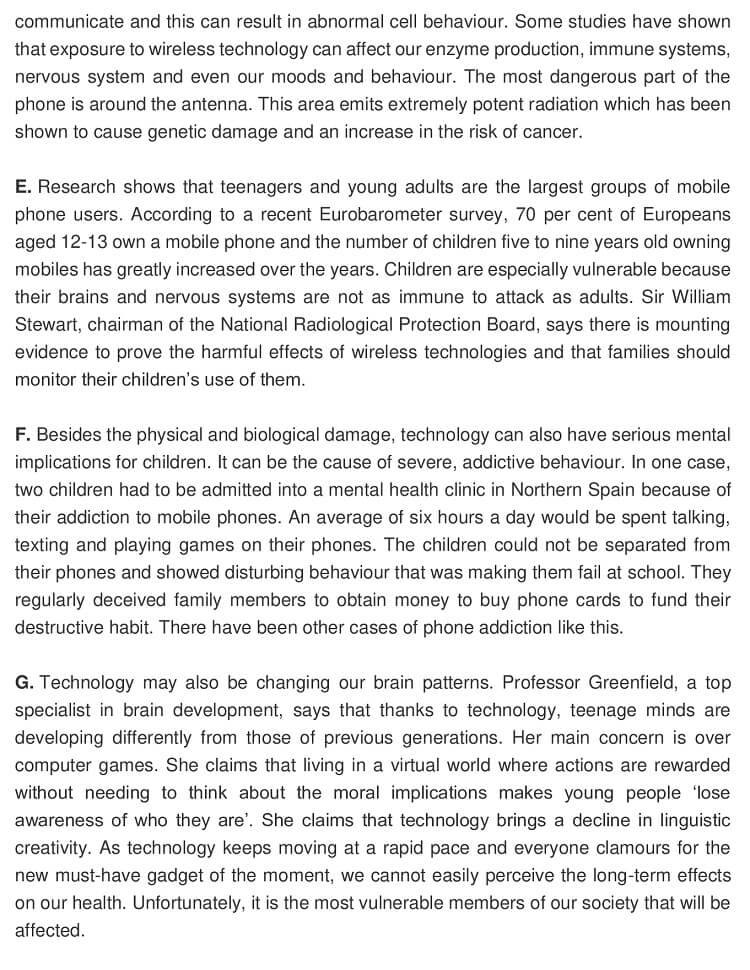
Question 14-18
Complete the table below
Write NO MORE THAN TWO WORDS AND/OR A NUMBER from the passage for each answer.
How MP3 players can threaten the health
| MP3 player features | Harmful results | Effects | |
| Problem A | new14….. fit inside ears | creates intense sound | damage to hair cells & loss of hearing |
| Problem B | 15……. is distortion-free with clear quality sound | invites children to increase 16……. |
|
| Problem C | capable of producing sound at 17…….. | as loud as a lawnmower or chainsaw – over recommended safe 18……. | |
Questions 19-23
Do the following statements agree with the claims of the writer in Reading Passage 2? Write
YES, if the statement agrees with the writer’s views
NO, if the statement contradicts the writer’s views
NOT GIVEN, if it is impossible to say what the writer thinks about this
19 There are considerable benefits to our wireless world.
20 Wireless technology is a permanent part of our lives.
21 Exposure to EMR can lead to criminal behaviour.
22 It is possible to become obsessed with technology.
23 Using technology always helps with academic success.
Questions 24-26
24 According to Professor Greenfield, what kind of world do children occupy when playing computer games?
25 What does Professor Greenfield feel children don’t pay attention to when playing computer games?
26 According to Professor Greenfield, what may be lower in teenagers who play a lot of computer games?
Reading Passage 3
A History of Fingerprinting
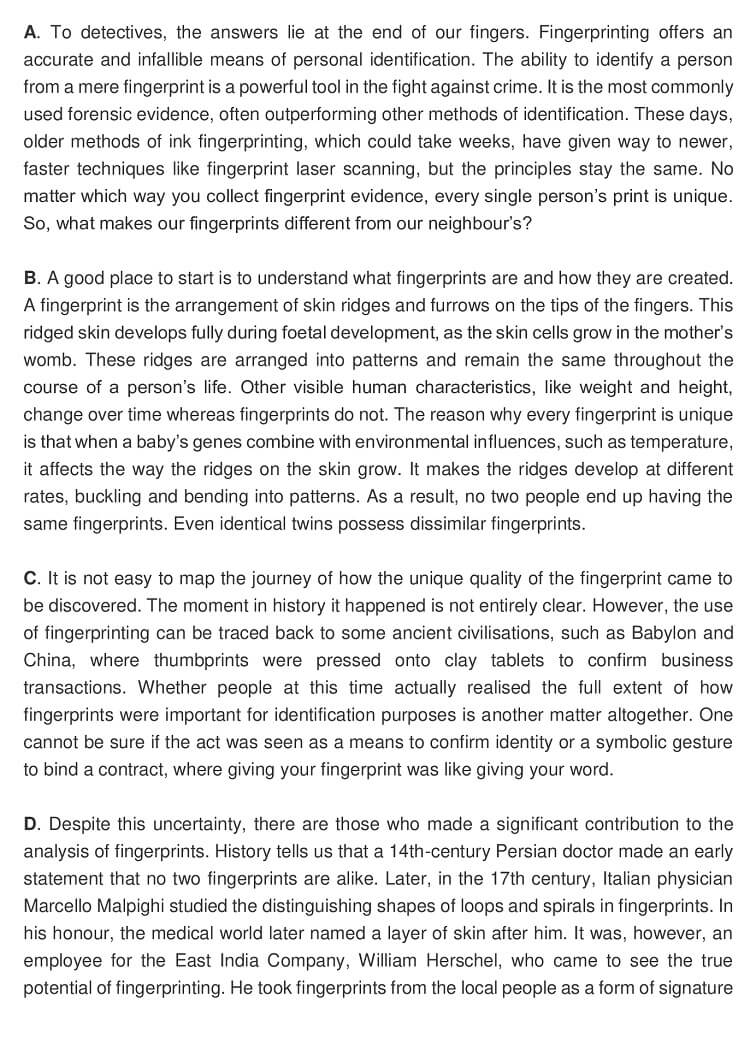
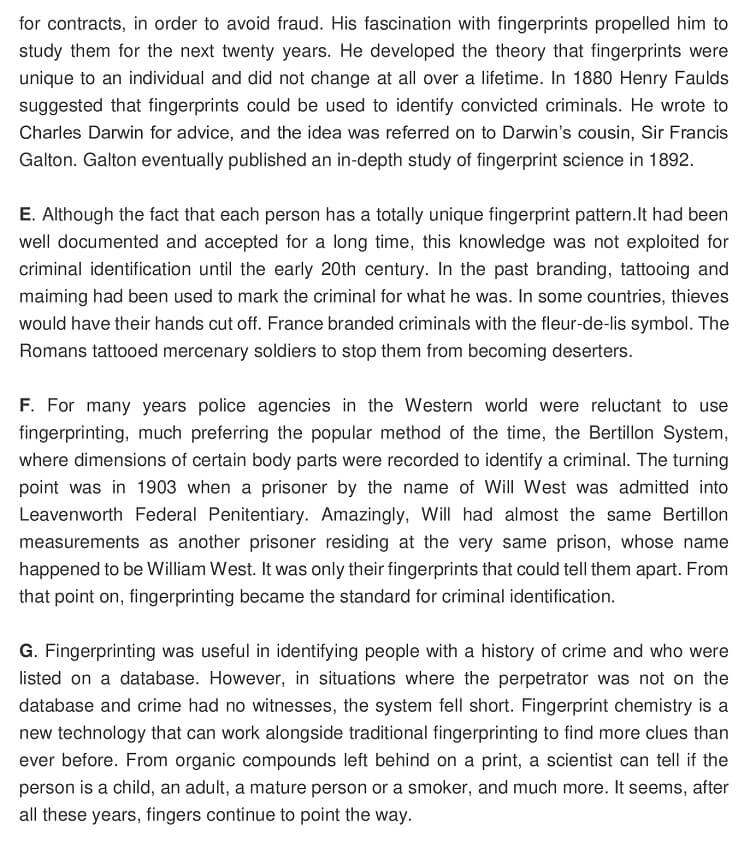
Questions 27-32
Reading Passage 3 has seven paragraphs, A-G.
Choose the correct heading for paragraphs B-G from the list of headings below.
| List of Headings | |
| i | Key people that made a difference |
| ii | An alternative to fingerprinting |
| iii | The significance of prints |
| iv | How to identify a criminal |
| v | Patterns in the making |
| vi | Family connections |
| vii | Exciting new developments |
| viii | A strange coincidence |
| ix | Punishing a criminal |
| X | An uncertain past |
| Example | |
| iii | Paragraph A |
| 27……………… | Paragraph B |
| 28…………….. | Paragraph C |
| 29……………… | Paragraph D |
| 30……………… | Paragraph E |
| 31……………… | Paragraph F |
| 32……………… | Paragraph G |
Questions 33-35
Complete the sentences.
Choose NO MORE THAN TWO WORDS from the passage for each answer.
33 Unlike other_____________________________ that you can see, fingerprints never change.
34 Although genetically the same, ________________________ do not share the same fingerprints.
35 A fingerprint was a substitute for a______________________ in Indian contracts.
Questions 36-40
Do the following statements agree with the information given in Reading Passage 3? Write
TRUE, if the statement agrees with the information
FALSE, if the statement contradicts the information
NOT GIVEN, if there is no information on this
36 Fingerprinting is the only effective method for identifying criminals.
37 The ridges and patterns that makeup fingerprints develop before birth.
38 Malpighi conducted his studies in Italy.
39 Roman soldiers were tattooed to prevent them from committing violent crimes.
40 Fingerprint chemistry can identify if a fingerprint belongs to an elderly person.
Answers
Unlock Answer
Signup/Login and get access to the answers
The Need to Belong Reading Answers (Passage 1)
1 Answer: role
Question type: Summary Completion
Answer locations: Paragraph B, line 1
Answer explanations: The introductory line in paragraph B states that people in the past hunted and cooked together in tribes and each member of the group would be assigned a role. Thus, it is evident that each person in the group had a role to play. So, the answer is role.
2 Answer: survival
Question type: Summary Completion
Answer locations: Paragraph B, line 4 – 5
Answer explanations: We find reference in the fourth line of paragraph B, which mentions that to the prehistoric ancestors, membership of a group meant the difference between survival and death. We understand that belonging to a group created a difference between survival and death. So, the answer is survival.
3 Answer: the wild
Question type: Summary Completion
Answer locations: Paragraph B, line 6 – 7
Answer explanations: We understand from the 6th line of Paragraph B that those who were rejected from a group had to fend and struggle to survive alone in the wild. Thus, it is clear that death could be avoided by living alone in the wild. So, the answer is wild.
4 Answer: protection
Question type: Summary CompletionAnswer locations: Paragraph B, line 2
Answer explanations: We understand from the 2nd line of Paragraph B, which illustrates that each member in the group had a purpose, that is if one group member is lost, the entire group would suffer, for this reason, the group had vested interest in protecting each other. These lines indicate that living with other members of the group offered protection. So, the answer is protection.
5 Answer: genes
Question type: Summary Completion
Answer locations: Paragraph B, line 7
Answer explanations: The 7th line of Paragraph B states that apart from protection, being part of a group ensured that genes could be passed onto future generations. These lines illustrate that along with protection, genes could also be passed to future generations if a member stays in a group. So, the answer is genes.
6 Answer: American football
Question type: Flowchart Completion
Answer locations: Paragraph D, line 5
Answer explanations: We find reference in the 5th line of Paragraph D, which illustrate that Larkin and her co-workers took a group of student volunteers and had them play a game known as Cyberball, a ball tossing arcade game similar to American Football. These lines indicate that Larkin and her coworkers made the volunteers believe that they were playing a cybergame, which resembled to American Football. So, the answer is American Football.
7 Answer: passing the ball
Question type: Flowchart Completion
Answer locations: Paragraph D, line 8
Answer explanations: We find reference in the 8th line of Paragraph D, which states that the computer was manipulating the game by passing the ball to some volunteers and excluding others. We understand from these lines that the computer had a power to control the game, which passed the ball to some volunteers and excluded others. Thus, the answer is passing the ball.
8 Answer: opinions
Question type: Flowchart Completion
Answer locations: Paragraph E, line 1
Answer explanations: The introductory line of Paragraph E, states that the accepted and rejected students were then asked if they enjoyed the game and about their opinions of the other players. These lines reveal that the accepted and rejected students were asked about their opinion on the game and other players after the game was concluded. So, the answer is opinions.
9 Answer: filmed
Question type: Flowchart Completion
Answer locations: Paragraph E, line 2
Answer explanations: The second line of Paragraph E, mentions that participants were put alone in a room and their natural foot movements were filmed. We understand from these lines that each participant had to go alone in a room where their natural foot movements were filmed. So, the answer is filmed.
10 Answer: moved her feet
Question type: Flowchart Completion
Answer locations: Paragraph E, line 3 – 4
Answer explanations: We understand from the 3rd line of Paragraph E, that a female entered the room under the pretence of conducting a fake photo description task where she deliberately moved her foot, not in a way that would be noticeable to the volunteer. These lines indicate that a woman entered a room and deliberately moved her foot during the task with the intention of not being noticed by the volunteer. So, the answer is moved her feet.
11 Answer: A
Question type: Multiple Choice Question
Answer locations: Paragraph A
Answer explanations: The introductory line of Paragraph A illustrates that no one likes to feel left out, ignored by colleagues at meetings or not be involved in the big party that everyone one is talking about. Imagine not being part of a joke, or worse still, if the joke is on you. These lines indicate how there are adverse consequences of not being included or being excluded or made fun of or not getting invited to a party. However, Paragraph A doesn’t mention any expert’s opinions on evolution. So, the answer is A.
12 Answer: B
Question type: Multiple Choice Question
Answer locations: Paragraph C, line 3
Answer explanations: The 3rd line of Paragraph C mentions that one obvious way people try to be accepted into a group is self-presentation, which is the act of portraying yourself in the best possible light. We understand from these lines of Paragraph C that people try to portray themselves in their best-self to be accepted into a group, where they can reveal themselves in the best way. Thus, the answer is B.
13 Answer: C
Question type: Multiple Choice Question
Answer locations: Paragraph G, line 4
Answer explanations: We find reference in the 4th line of Paragraph G, which illustrate that it happens and it will continue to happen because the desire to belong is a very powerful force and a fundamental part of human nature. These lines indicate that people desiring to belong to a group is a powerful force and a basic and primary part of human nature. The writer tries to convey in the article how humans desire to belong to a group and how they do many things unconsciously to gain membership to the group. Thus, the answer is C.
Is Technology Harming our Children’s Health? Reading Answers (Passage 2)
14 Answer: headphones
Question type: Table Completion
Answer locations: Paragraph B
Answer explanations: The introductory line of Paragraph B illustrates an example, that old-fashioned headphones have been replaced with smaller ones that fit neatly into the ear, instead of over them, which intensifies the sound. These lines indicate that old-fashioned headphones were replaced with smaller ones that fit neatly into the ear intensifying the sound. Thus, the answer is headphones.
15 Answer: digital music
Question type: Table Completion
Answer locations: Paragraph B, line 2
Answer explanations: The second line of Paragraph B states that digital music does not distort and keeps its crystal clear sound even on loud settings encouraging children to crank up the volume. These lines illustrate that digital music is distortion-free with crystal clear sound. So, the answer is digital music.
16 Answer: the volume
Question type: Table Completion
Answer locations: Paragraph B, line 2 – 3
Answer explanations: We find reference in the second line of Paragraph B, which mentions that digital music does not distort and keeps its crystal clear sound even on loud settings encouraging children to crank up the volume. We understand from these lines that digital music is distortion-free with clear quality sound on loud settings, encouraging children to increase the volume. So, the answer is the volume.
17 Answer: 120 decibels
Question type: Table Completion
Answer locations: Paragraph B, line 6
Answer explanations: The 6th line in Paragraph B elucidates that in another perspective, most MP3 players can reach levels of 120 decibels, which is louder than a chainsaw or lawnmower. These lines indicate that MP3 can produce loud sounds reaching at 120 decibels, louder than the sound of chainsaw or a lawnmower. Thus, the answer is 120 decibels.
18 Answer: (decibel) level
Question type: Table Completion
Answer locations: Paragraph B, line 6
Answer explanations: We understand from the 6th line in Paragraph B that in another perspective, most MP3 players can reach levels of 120 decibels, which is louder than a chainsaw or lawnmower. When you consider 85 decibels in the maximum safe decibel level set by hearing experts over the course of a working day and that the children will listen to music at higher decibel levels. These lines indicate that MP3 can produce 120 decibel levels whereas the maximum safe decibel level set by hearing experts is 85 decibels. So, the answer is decibel level.
19 Answer: Yes
Question type: Yes/No/Not Given
Answer locations: Paragraph C
Answer explanations: The introductory line of Paragraph C mentions that we’re living in a wireless age. Calls can be made and received on mobiles from anywhere and the internet can be accessed without the need for cables. These lines indicate how technology has benefits and has made our lives easier. Thus, the answer is Yes.
20 Answer: Yes
Question type: Yes/No/Not Given
Answer locations: Paragraph C, line 4
Answer explanations: We find reference in the 4th line of Paragraph C, which states that it is clear that mobiles and wireless technology are here to stay but are we paying the price for new technology. These lines illustrate that wireless technology is a part of our life and we’re paying a price for this technology. Thus, the statement agrees with the information in Paragraph C, so, the answer is Yes.
21 Answer: Not Given
Question type: Yes/No/Not Given
Answer locations: Paragraph D, line 6
Answer explanations: We find reference for EMR in the 6th line of Paragraph D, which states that EMR can disrupt and alter the way in which our cells communicate, which can result in abnormal cell behavior. However, there’s no reference in Paragraph D that exposure to EMR leads to criminal behaviour. Thus, the answer is Not Given.
22 Answer: Yes
Question type: Yes/No/Not Given
Answer locations: Paragraph F
Answer explanations: We understand from the introductory line of Paragraph F that apart from the physical and biological damage, technology can also have serious mental implications for children. It can be the cause of severe, addictive behavior. These lines reveal that technology can be the cause of severe and addictive behavior. Thus, the statement agrees with the information. So, answer is Yes.
23 Answer: No
Question type: Yes/No/Not Given
Answer locations: Paragraph G, line 4
Answer explanations: We understand from the fourth line of Paragraph G that Professor Greenfield claims that living in a virtual world where actions are rewarded without needing to think about the moral implications makes young people lose awareness of who they’re. She also claims that technology brings a decline in linguistic creativity. These lines illustrate that living in a virtual world makes young people lose awareness of who they are and that the technology brings a decline in linguistic creativity. Thus, the statement disagrees or contradicts the information in Paragraph G. So, the answer is No.
24 Answer: (a) virtual (world)
Question type: Short Answer Questions
Answer locations: Paragraph G, line 4
Answer explanations: The fourth line of Paragraph G illustrates Professor Greenfield’s claims over computer games that living in a virtual world where actions are rewarded without needing to think about the moral implications makes young people lose awareness of who they’re. She also claims that technology brings a decline in linguistic creativity. These lines indicate that the virtual world occupies children’s minds when playing computer games. So, the answer is virtual world.
25 Answer: moral implications
Question type: Short Answer Questions
Answer locations: Paragraph G, line 4
Answer explanations: We find reference in 4th line of Paragraph G, which states the claims of Professor Greenfield over computer games. She mentions that living in a virtual world where actions are rewarded without needing to think about the moral implications makes young people lose awareness of who they’re. These lines indicate that it’s because of moral implications, children don’t pay attention when playing computer games. Thus, the answer is moral implications.
26 Answer: linguistic creativity
Question type: Short Answer Questions
Answer locations: Paragraph G, line 6
Answer explanations: We understand from the 6th line of Paragraph G, which illustrates claims of Professor Greenfield, that technology brings a decline in linguistic creativity. These lines indicate that technology brings a decline in linguistic creativity which may be lower in teenagers who play a lot of computer games. Thus, the answer is linguistic creativity.
A History of Fingerprinting Reading Answers (Passage 3)
27 Answer: v
Question Type: Matching Headings
Answer location: Paragraph B, line 1
Answer explanation: In the reference paragraph, it is given that “a good place to start is to understand what fingerprints are and how they are created. A fingerprint is the arrangement of skin ridges and furrows on the tips of the fingers.” “A good place to start is to understand what fingerprints are and how they are created” implies that it discusses the making of fingerprint patterns.
28 Answer: x
Question Type: Matching Headings
Answer location: Paragraph C, line 2
Answer explanation: Paragraph C puts forward the information that “the moment in history it happened is not entirely clear. However, the use of fingerprinting can be traced back to some ancient civilisations, such as Babylon and China, where thumbprints were pressed onto clay tablets to confirm business transactions.” The past is not very clear. So it represents an uncertain past.
29 Answer: i
Question Type: Matching Headings
Answer location: Paragraph D, line 1
Answer explanation: The answer is clearly mentioned in the said paragraph and line. You must note the paraphrasing here. In the passage, it is said that “despite this uncertainty, there are those who made a significant contribution towards the analysis of fingerprinting.” Significant people indicates key people who made the difference.
30 Answer: iv
Question Type: Matching Headings
Answer location: Paragraph E, line 2
Answer explanation: The author states “this knowledge was not exploited for criminal identification until the early 20th century. In the past branding, tattooing and maiming had been used to mark the criminal for what he was.” It suggests that branding, tattooing, and maiming were used in the past to identify a criminal.
31 Answer: viii
Question Type: Matching Headings
Answer location: Paragraph F, line 4
Answer explanation: In the said paragraph, you can refer to, “amazingly, Will had almost the same Bertillon measurements as another prisoner residing at the very same prison, whose name happened to be William West. It was only their fingerprints that could tell them apart. From that point on, fingerprinting became the standard for criminal identification.” Since Will had almost the same Bertillon measurements as another prisoner, it indicates a strange coincidence.
32 Answer: vii
Question Type: Matching Headings
Answer location: Paragraph G, line 3
Answer explanation: In the said paragraph, you can refer to, “fingerprint chemistry is a new technology that can work alongside traditional fingerprinting to find more clues than ever before. From organic compounds left behind on a print, a scientist can tell if the person is a child, an adult, a mature person, or a smoker, and much more. It seems, after all these years, fingers continue to point the way.” From the given information, we can infer the significant advancements in the field of fingerprint analysis including detecting the organic substance left on the print, determining a person’s age – whether he is a kid, adult, or mature person, and much more.
33 Answer: (human) characteristics
Question Type: Sentence Completion
Answer location: Paragraph B, line 4
Answer explanation: The entire sentence has been paraphrased here. In the passage, it states “these ridges are arranged into patterns and remain the same throughout the course of a person’s life. Other visible human characteristics, like weight and height, change over time whereas fingerprints do not.” Hence, other visible human characteristics like weight and height can undergo changes, but fingerprints do not.
34 Answer: identical twins
Question Type: Sentence Completion
Answer location: Paragraph B, last line
Answer explanation: A line in the paragraph denotes “even identical twins possess dissimilar fingerprints.” Hence, according to the passage, even identical twins do not share similar fingerprints.
35 Answer: signature
Question Type: Sentence Completion
Answer location: Paragraph D, line 5
Answer explanation: Paragraph D puts forward the information that “it was, however, an employee for the East India Company, William Herschel, who came to see the true potential of fingerprinting. He took fingerprints from the local people as a form of signature for contracts, in order to avoid fraud. His fascination with fingerprints propelled him to study them for the next twenty years. He developed the theory that fingerprints were unique to an individual and did not change at all over a lifetime.” East India Company in the past took fingerprints as a substitute for signature in Indian contracts.
36 Answer: FALSE
Question Type: True/False/Not Given Questions
Answer location: Paragraph A, line 2
Answer explanation: Fingerprinting is not the only effective method in identifying criminals because “fingerprinting offers an accurate and infallible means of personal identification. The ability to identify a person from a mere fingerprint is a powerful tool in the fight against crime.” Hence, we can infer that fingerprint is one of the powerful tools to fight against crime.
37 Answer: TRUE
Question Type: True/False/Not Given Questions
Answer location: Paragraph B, line 3
Answer explanation: A line in the passage mentions that “this ridged skin develops fully during foetal development, as the skin cells grow in the mother’s womb. These ridges are arranged into patterns and remain the same throughout the course of a person’s life.” The ridges and patterns of skin cells form (makeup) fingerprints develop before birth.
38 Answer: NOT GIVEN
Question Type: True/False/Not Given Questions
Answer location: Paragraph D, line 3
Answer explanation: The paragraph suggests that “later, in the 17th century, Italian physician Marcello Malpighi studied the distinguishing shapes of loops and spirals in fingerprints.” Though Malpighi was an Italian physician , there is no information about where he conducted his research.
39 Answer: FALSE
Question Type: True/False/Not Given Questions
Answer location: Paragraph E, last line
Answer explanation: Paragraph E puts forward the information that “the Romans tattooed mercenary soldiers to stop them from becoming deserters.” Desertion is the abandonment of a military duty or post without permission and is done with the intention of not returning. Hence, we confirm that soldiers were tattooed to stop them from becoming deserters and not to prevent them from committing violent crimes.
40 Answer: TRUE
Question Type: True/False/Not Given Questions
Answer location: Paragraph G, line 3
Answer explanation: If you read thoroughly, a line in the passage specifies that “fingerprint chemistry is a new technology that can work alongside traditional fingerprinting to find more clues than ever before. From organic compounds left behind on a print, a scientist can tell if the person is a child, an adult, a mature person or a smoker, and much more. It seems, after all these years, fingers continue to point the way.” Fingerprint chemistry is a new technology that can help to identify if the person is a child, an adult (elderly person), a mature person or a smoker, and much more.
Practice IELTS Reading based on question types

Start Preparing for IELTS: Get Your 10-Day Study Plan Today!
Explore other Reading Practice Tests

Nehasri Ravishenbagam

Nehasri Ravishenbagam
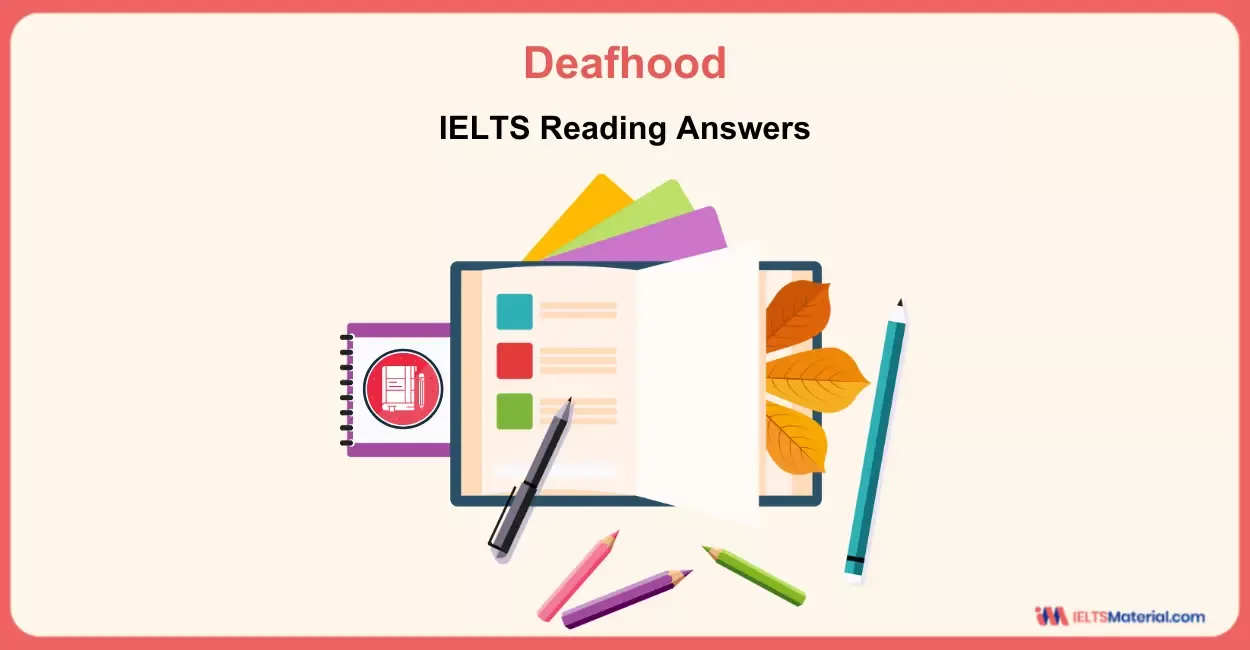
Kasturika Samanta

Kasturika Samanta
Recent Articles

Nehasri Ravishenbagam

Haniya Yashfeen

Haniya Yashfeen

Haniya Yashfeen
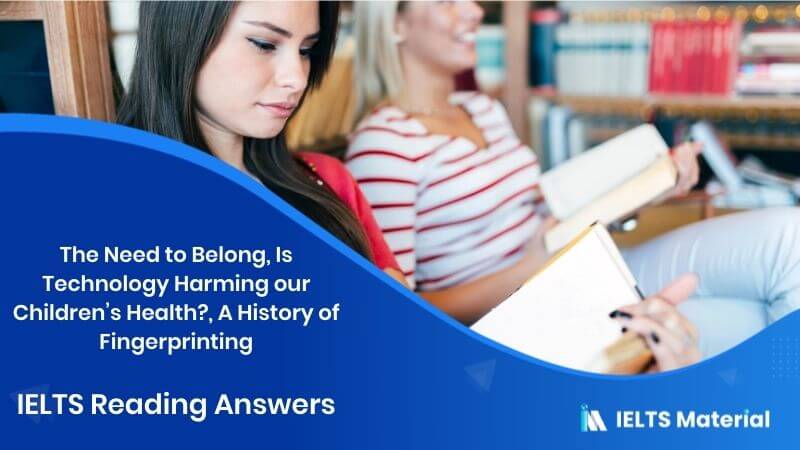


Post your Comments